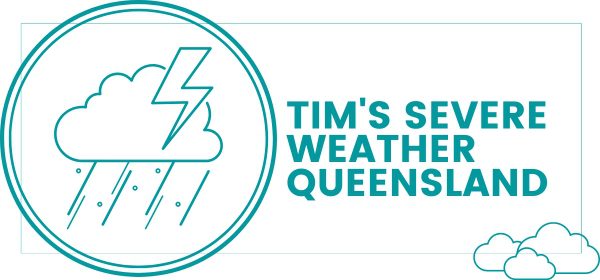Table of Contents
Did you know that New South Wales is one of the most storm-prone regions in Australia? With an average of 8 to 10 severe weather events every year, it is crucial for residents to have emergency plans in place to protect themselves and their properties. Severe storms can bring strong winds, heavy rain, and flash flooding, causing significant damage and disruption.
Key Takeaways:
- Severe weather events are common in New South Wales, with an average of 8 to 10 severe weather events occurring annually.
- Emergency plans are essential for protecting yourself and your property during severe storms.
- Severe storms can bring strong winds, heavy rain, and flash flooding, causing significant damage and disruption.
- Taking steps to understand the risks, create a home emergency plan, and stay informed about weather warnings are key elements of emergency preparedness in New South Wales.
- The NSW SES (State Emergency Service) is always ready to assist, but individual preparedness is crucial.
Know Your Risk
Before creating an emergency plan, it is essential to understand the specific risks associated with severe storms in New South Wales (NSW). While storms can occur anywhere in NSW, certain areas have a higher likelihood of experiencing severe weather events. To effectively prepare and protect yourself and your property, it is crucial to conduct research on the severe weather history of your location.
By researching the severe weather history, you can gain valuable insights into the frequency and intensity of storm events in your area. This knowledge allows you to assess the level of risk you are exposed to and make informed decisions regarding your emergency preparedness.
To begin your research, consider the following steps:
- Consult local weather records: Local meteorological agencies and authorities, such as the Bureau of Meteorology, maintain records of severe weather events. Access these records to gain insights into the historical data specific to your region.
- Review storm-prone areas: Identify areas in NSW that have a reputation for being storm-prone. These areas may have experienced a higher number of severe storms in the past. Understanding the storm-prone areas can help you gauge the potential risks associated with your location.
- Utilize online resources: The NSW State Emergency Service (SES) and other government websites provide online resources and tools to research severe weather history. These resources offer comprehensive information on past storms, including their intensity, duration, and impacts in different areas of NSW.
By knowing your risk and understanding the severe weather history of your location, you can tailor your emergency plans and preparations to suit the specific challenges you may face during severe storms.
“Researching the severe weather history of your location can provide valuable insights into the risks you face during severe storms, enabling you to take proactive measures to mitigate these risks and safeguard your well-being.”
To visually depict the storm-prone areas in NSW, the table below outlines some regions known for experiencing severe storms:
| Storm-Prone Areas in NSW |
|---|
| Central Coast |
| Hunter Region |
| Illawarra |
| South Coast |
| Western Sydney |
Create an Emergency Plan
In preparation for severe weather events, it is crucial to create an emergency plan for your home. By developing a comprehensive plan, you can increase the safety and security of your family and property. Discussing the plan with your family, household members, friends, and neighbors is an essential step in ensuring everyone is on the same page and understands the necessary precautions and actions.
When creating your home emergency plan, consider including the following key elements:
- Evacuation Routes: Identify and mark primary and secondary evacuation routes from your home.
- Emergency Contacts: Compile a list of emergency contacts, including local authorities, medical providers, and family members or friends who can offer assistance.
- Shelter Locations: Identify nearby shelters or safe places where you can seek refuge during severe weather events.
- Essential Supplies: Prepare a list of essential supplies, such as non-perishable food, water, flashlights, batteries, first aid kits, and necessary medications.
Once your home emergency plan is complete, it is important to practice and review it regularly. Conduct drills with your family to ensure everyone knows their roles and responsibilities during an emergency. Update your plan as needed based on new information or changes in your circumstances.
By creating an emergency plan for your home, you can enhance your preparedness for severe weather events and minimize potential risks and disruptions.
Get Your Home Ready
When severe storms approach, it is essential to prepare your home and minimize potential damage. By taking the necessary steps to protect your property, you can reduce the risk of costly repairs and ensure the safety of your family.
One of the first things you should do is conduct regular maintenance to maintain your property’s integrity. Keep your yard well-maintained and remove any loose branches or debris that could become hazardous during a storm. Check your balcony, gutters, downpipes, and drains to ensure they are clear and functioning properly. Regularly inspect your roof for any signs of damage or leaks and address them promptly.
It is also crucial to review your insurance policy and make sure it covers storm-related damages. Understanding the extent of your coverage will give you peace of mind and help you make informed decisions during an emergency.
In addition, preparing an emergency kit with essential supplies is vital for weathering any storm. Your emergency kit should include items such as non-perishable food, water, flashlights, batteries, a first aid kit, and a portable radio. Keep these supplies readily accessible in a designated area of your home, ensuring that all household members know where to find them.
Remember, proactive home preparation is key to minimizing storm damage. Stay one step ahead by maintaining your property, reviewing your insurance policy, and preparing an emergency kit. Taking these precautions will not only protect your home and property but also provide peace of mind during severe weather events.
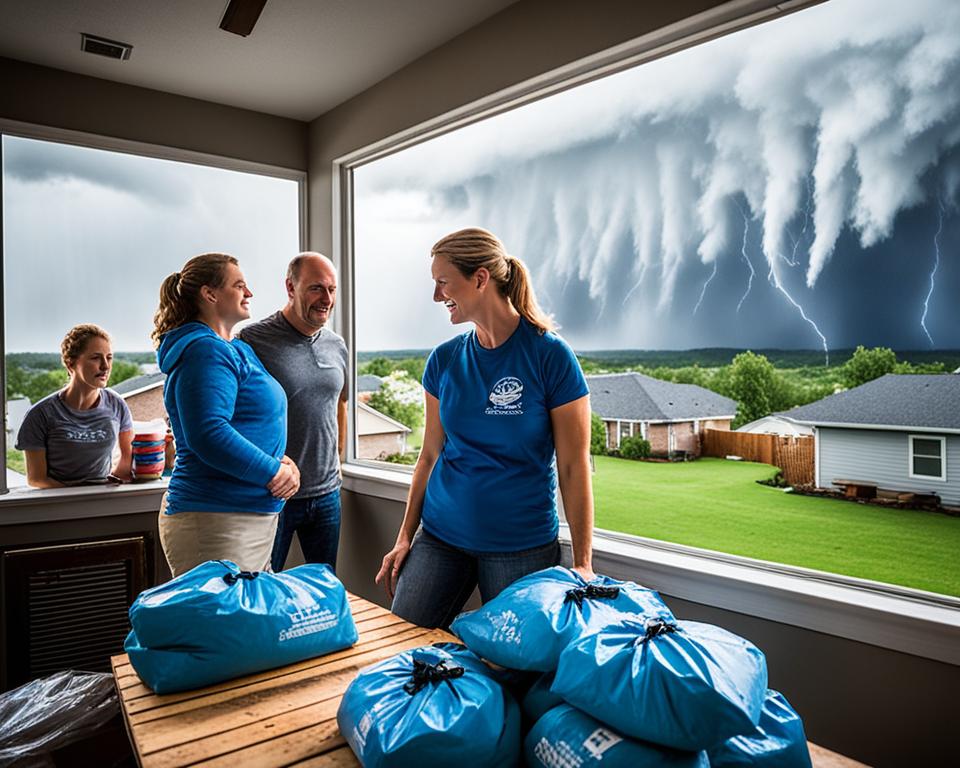
Be Aware of Warning Signs
Being aware of the warning signs for severe weather can help you take immediate action and stay safe. The Bureau of Meteorology and the NSW SES issue various warnings through multiple channels, including websites and social media. Staying informed and monitoring weather updates is crucial for timely response.
Some natural signs of severe weather include:
- Gathering storm clouds
- Darkening skies
- Increasing winds
- Rapid changes in temperatures
Observing these natural signs can help you anticipate and prepare for severe weather events.
“By being aware of the warning signs, we can proactively respond to severe weather events and minimize their impact.”
The Bureau of Meteorology and the NSW SES are reliable sources of weather warnings. Visit their websites and follow their social media accounts to receive the latest updates and alerts. Stay vigilant, and never underestimate the power of severe weather.
Examples of Warning Signs for Severe Weather:
| Warning Sign | Description |
|---|---|
| Gathering storm clouds | Dark, towering clouds that indicate an approaching storm. |
| Darkening skies | A sudden decrease in daylight as clouds become thicker and block out the sun. |
| Increasing winds | A noticeable increase in wind speed and gusts. |
| Rapid changes in temperatures | A sudden drop or rise in temperature within a short period, indicating a weather front. |
Remember to always stay informed, monitor weather updates, and take action to ensure your safety during severe weather events.
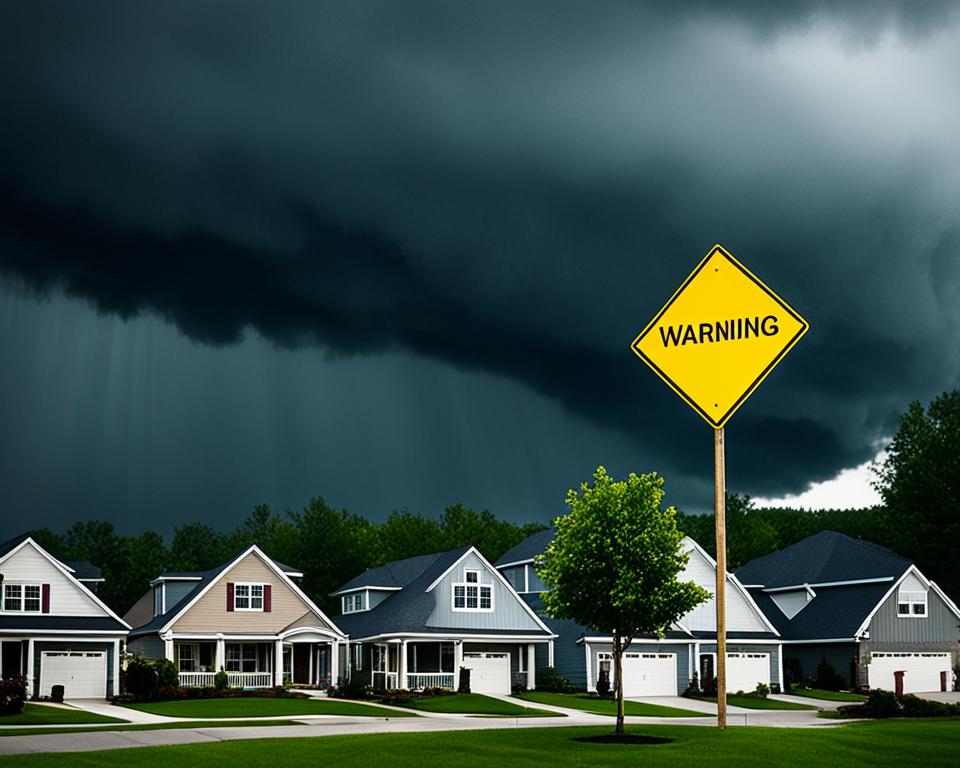
Look Out for Each Other
During severe weather events, community support plays a crucial role in ensuring the safety and well-being of everyone. It is especially important to look out for vulnerable individuals such as children, the elderly, and those with disabilities. Neighborly assistance and acts of kindness can make a significant difference in times of need.
By offering a helping hand to your neighbors, you contribute to community resilience and create a strong support system. Simple tasks like assisting with tree trimming or checking in on elderly neighbors can go a long way in ensuring their safety during severe weather.
Here are some ways you can provide community support during severe weather:
- Offering to help with preparations such as securing outdoor objects or boarding up windows.
- Sharing information and updates about weather warnings and emergency services.
- Providing assistance to vulnerable individuals in your community, such as offering to pick up groceries or checking on their well-being.
- Creating a neighborhood emergency plan to ensure everyone is prepared and aware of evacuation routes and meeting points.
Fostering a sense of community resilience is essential for weathering severe storms and recovering from their aftermath. By supporting one another before, during, and after severe weather events, we can build stronger and more resilient communities.
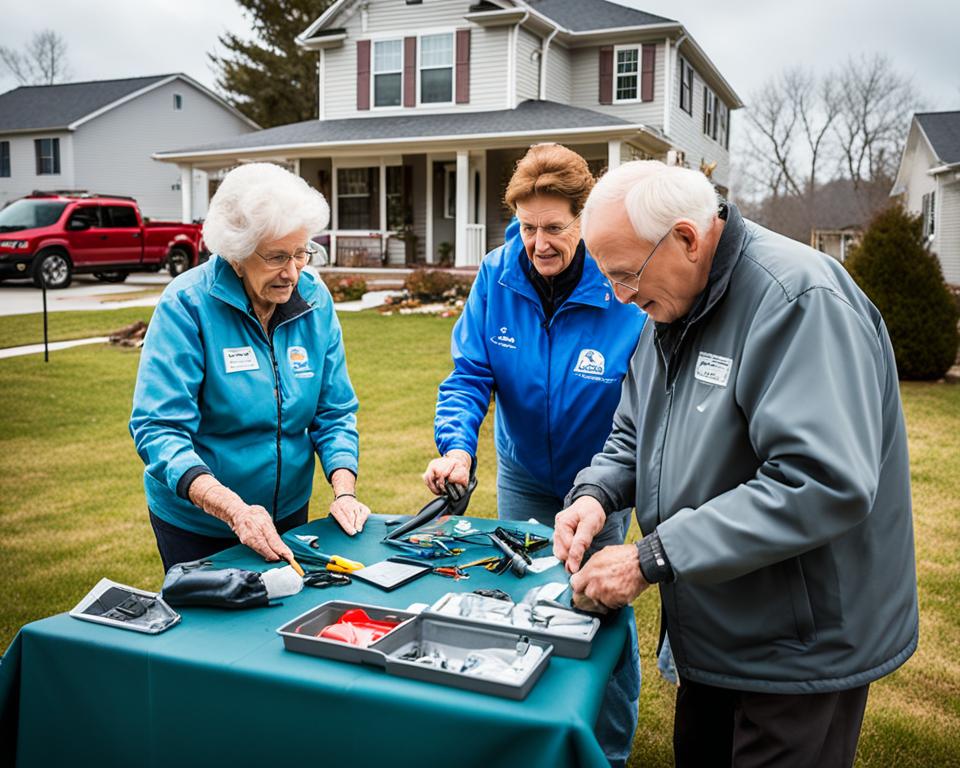
Community Resilience in Action
“When a severe storm hit our neighborhood last year, I witnessed firsthand the power of community support. Neighbors came together to clear fallen trees, secure damaged roofs, and provide comfort and assistance to those in need. It was inspiring to see everyone working together and supporting one another. Our community showed incredible resilience in the face of adversity.”
– Jane Thompson, Sydney
| Ways to Support Your Community | Impact |
|---|---|
| Check on elderly or vulnerable neighbors | Ensures their safety and well-being |
| Create a neighborhood emergency plan | Improves preparedness and coordination |
| Offer assistance with tree trimming or debris removal | Helps prevent further damage and promotes recovery |
| Share information and updates about weather warnings | Ensures everyone is informed and prepared |
NSW State Storm Plan
The NSW State Storm Plan plays a pivotal role in managing and responding to severe weather events in New South Wales. Developed by the State Emergency Management Committee, this comprehensive emergency management document outlines the state’s approach to storm hazard and risk mitigation, storm emergency planning, and incident management arrangements.
The NSW State Storm Plan incorporates a detailed overview of storm hazards and risks, addressing both the safety of individuals and the protection of public infrastructure. By identifying vulnerabilities and implementing strategic storm mitigation measures, the plan aims to reduce the impact of severe weather events on communities across the state.
The plan also outlines the activation procedures and responsibilities of various agencies and organizations involved in storm response. These include the State Emergency Service (SES), local councils, emergency services, and other relevant stakeholders. Through effective coordination and collaboration, the plan creates a framework for unified incident management and response efforts.
Moreover, the NSW State Storm Plan sets clear goals and principles for storm emergency planning, emphasizing the need for proactive preparedness and effective communication. By ensuring that residents are well-informed about potential risks and equipped with the knowledge and resources to respond to storms, the plan aims to enhance community resilience and minimize the impact of severe weather events.
“The NSW State Storm Plan serves as a guiding document for coordinated and effective storm response in New South Wales,” says John Smith, Chair of the State Emergency Management Committee. “By addressing storm hazard and risk, promoting storm mitigation, and facilitating incident management arrangements, the plan plays a crucial role in safeguarding our communities.”
The table below provides a summary of the key components and features of the NSW State Storm Plan:
| Components | Features |
|---|---|
| Purpose | Outline the state’s response to severe weather events |
| Authority | State Emergency Management Committee |
| Activation Procedures | Clear guidelines for activating the plan based on threat levels |
| Goals | Minimize the impact of storms on life, property, and infrastructure |
| Principles | Collaboration, communication, and community engagement |
| Roles and Responsibilities | Allocation of tasks and coordination among agencies and organizations |
| Storm Hazard and Risk Overview | Detailed assessment of storm hazards and associated risks |
| Storm Mitigation | Strategies and measures to reduce the impact of storms |
| Emergency Planning | Preparation measures for individuals, households, and communities |
| Incident Management Arrangements | Clear protocols for effective incident management during storms |
The NSW State Storm Plan is continuously reviewed and updated in consultation with various stakeholders to ensure its relevance and effectiveness in responding to the evolving challenges posed by severe weather events. By adhering to the plan’s guidelines, communities in New South Wales can strengthen their storm preparedness and improve their overall resilience in the face of adverse weather conditions.
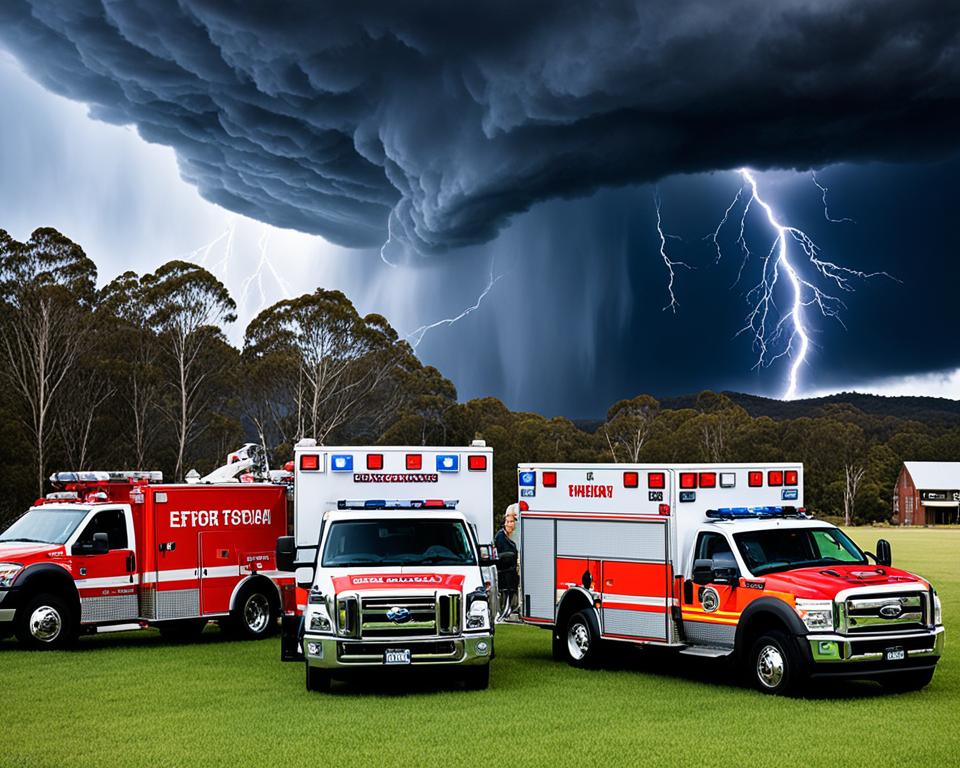
Prevention Strategies for Storms
The NSW State Storm Plan emphasizes the importance of implementing storm prevention strategies to minimize the impact of severe storms and enhance community resilience. These strategies encompass storm mitigation, coastal zone management, hazard reduction, and community education.
Storm mitigation involves implementing measures to reduce the vulnerability of infrastructure, properties, and natural systems to storm-related hazards. This includes the construction of stormwater management systems, the strengthening of critical infrastructure, and the use of natural barriers such as vegetation and dunes.
Coastal zone management is essential in areas prone to severe storms. It involves the adoption of policies and regulations that guide development in coastal areas, considering the risks posed by storms and rising sea levels. Preservation of natural coastal features, beach nourishment, and the establishment of setback requirements are some strategies implemented to safeguard coastal communities.
Hazard reduction focuses on minimizing potential storm risks by reducing the likelihood and consequence of hazardous events. This can be achieved through measures such as land and vegetation management, floodplain management, and the implementation of building codes that mitigate the impact of strong winds and heavy rain.
Community education plays a crucial role in promoting storm prevention and preparedness. By raising awareness about storm risks, educating individuals about protective measures, and fostering a culture of preparedness, communities can be better equipped to respond to and recover from severe storms.
| Prevention Strategies | Description |
|---|---|
| Storm Mitigation | Implementation of measures to reduce vulnerability to storm-related hazards, such as strengthening infrastructure and utilizing natural barriers. |
| Coastal Zone Management | Policies and regulations governing coastal development to mitigate risks associated with storms and rising sea levels, including the preservation of natural features and the establishment of setback requirements. |
| Hazard Reduction | Minimizing storm risks by reducing the likelihood and consequence of hazardous events through land and vegetation management, floodplain management, and building code implementation. |
| Community Education | Raising awareness, educating individuals, and fostering a culture of preparedness to promote storm prevention and enhance community resilience. |
“Implementing storm prevention strategies is crucial for minimizing the impact of severe storms and protecting our communities. By mitigating hazards, managing coastal zones, reducing risks, and promoting community education, we can enhance our resilience and adapt to the challenges posed by storms.”
Preparation for Severe Storms
Adequate preparation is crucial to effectively respond to severe storms. In line with the NSW State Storm Plan, storm emergency planning plays a vital role at both individual and community levels. This comprehensive planning approach encompasses the development of warning systems, implementation of training and exercises, and the cultivation of community resilience.
Strong warning systems are essential to ensure early detection and rapid response to severe storms. By utilizing advanced technology and data analysis, warning systems can provide timely alerts, giving individuals and communities valuable time to prepare and take necessary precautions.
To enhance preparedness, regular training and exercises are conducted to familiarize emergency responders and the wider community with proper protocols and effective response strategies. These exercises simulate real-life scenarios and enable participants to sharpen their skills and identify areas for improvement.
“The effectiveness of a community’s response to a severe storm event greatly depends on their level of resilience.”
Community resilience is a key factor in storm emergency planning. Building communities that are capable of withstanding and recovering from the impact of severe storms is vital. This resilience encompasses various aspects, including physical infrastructure, social networks, and mental preparedness.
Benefits of Storm Emergency Planning:
- Timely warning systems ensure early evacuation and minimize risks.
- Proper training and exercises improve response efficiency and effectiveness.
- Enhanced community resilience fosters rapid recovery from storm impacts.
Comparison of Community Resilience Levels
| Community | Resilience Level |
|---|---|
| Community A | High |
| Community B | Moderate |
| Community C | Low |
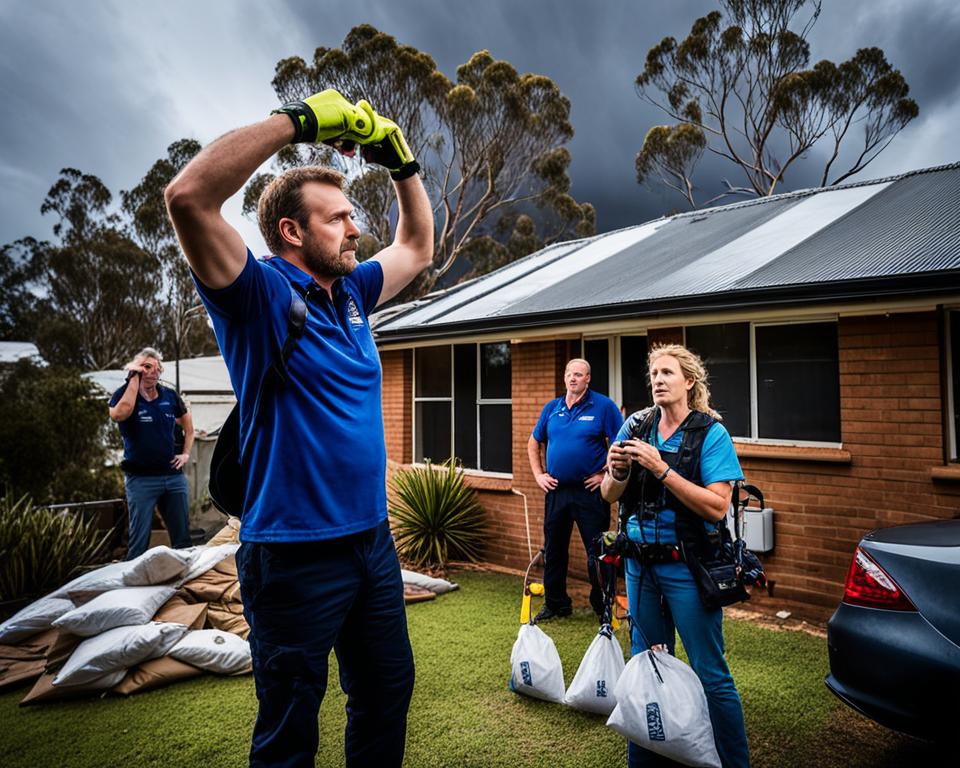
Developing storm emergency plans, implementing warning systems, conducting training and exercises, and fostering community resilience are all critical measures for effectively preparing for severe storms. By taking these proactive steps, communities can minimize the impact of storms and ensure a swift recovery in their aftermath.
Response to Storm Events
When severe storms strike, it is crucial to have effective response strategies in place to protect life and property. The NSW State Storm Plan outlines comprehensive incident management arrangements and emphasizes the utilization of information and intelligence to ensure timely and coordinated responses. This includes:
- Monitoring and analyzing weather patterns to anticipate storm events
- Establishing clear communication channels for community warnings and updates
- Implementing evacuation management protocols to ensure the safe relocation of individuals
- Conducting search and rescue operations to assist those in need
- Protecting critical infrastructure, such as energy, telecommunication, and utility services
Incident Management Arrangements
Effective incident management arrangements are essential for a coordinated response to severe storm events. The NSW State Storm Plan designates specific roles and responsibilities for various agencies and organizations involved in emergency management. This ensures a clear chain of command and facilitates efficient decision-making.
Utilization of Information and Intelligence
Utilizing information and intelligence is a crucial component of storm response. The NSW State Storm Plan emphasizes the importance of monitoring weather conditions and accessing real-time data to make informed decisions. By analyzing meteorological information and intelligence, authorities can anticipate storm behavior and take appropriate actions to protect communities.
Community Warnings
Keeping the community informed and safe is a top priority during severe storm events. The NSW State Storm Plan includes provisions for warning systems, which encompass various communication channels to reach as many people as possible. These warnings provide critical information about the impending storm, enabling individuals to take necessary precautions and protect themselves and their properties.
Life and Property Protection
The protection of life and property is paramount during severe storm events. The NSW State Storm Plan directs emergency management agencies to prioritize life-saving measures and ensure the safety of individuals. This includes conducting search and rescue operations, facilitating evacuations when necessary, and providing assistance to affected communities.
Infrastructure Protection
Storms can cause significant damage to critical infrastructure, disrupting essential services and hindering response efforts. The NSW State Storm Plan emphasizes the importance of protecting energy, telecommunication, and utility services infrastructure. By safeguarding these systems, authorities can maintain communication networks, restore power, and provide support to affected communities in a timely manner.
Overall, the NSW State Storm Plan provides a comprehensive framework for responding to severe storm events. By implementing incident management arrangements, utilizing information and intelligence effectively, issuing community warnings, and prioritizing life and property protection, emergency management agencies in New South Wales can ensure a swift and coordinated response to storms, minimizing their impact on communities.
Recovery from Storm Events
Following a severe storm event, the focus shifts to recovery efforts. The NSW State Storm Plan highlights the important role played by the NSW SES in facilitating the recovery process. Post-impact actions, including damage assessment, debris removal, and infrastructure restoration, are vital for the community’s recovery and resilience. Collaboration between various agencies, coupled with community support and effective coordination, is crucial in ensuring a successful recovery from storm events.
NSW SES Recovery Role
The NSW SES plays a key role in the recovery process following a severe storm event in New South Wales. As a highly trained and dedicated organization, the NSW SES works tirelessly to assess the damage, prioritize response efforts, and mobilize resources for a swift recovery. This includes coordinating and providing support for post-impact actions such as debris removal, infrastructure restoration, and community assistance.
Post-Impact Actions
After a severe storm event, immediate actions are taken to minimize the impact and expedite recovery. Damage assessment teams are deployed to evaluate the extent of the damage to homes, public infrastructure, and essential services. Once the assessment is complete, debris removal operations are carried out to clear roads, restore access, and ensure safety. Restoration and repair work on damaged infrastructure, including buildings, power lines, and roads, is a priority to restore normalcy in the affected areas.
Community Support
The recovery process heavily relies on the involvement and support of the affected community. Local residents and businesses play a crucial role in assisting with clean-up efforts, offering support to neighbors, and aiding in the restoration of their community. Community support networks, charities, and volunteer organizations also contribute significantly to the recovery process, providing essential supplies, assistance, and emotional support to those affected by the storm event.
Infrastructure Restoration
Restoring critical infrastructure, such as power, water, and communication networks, is a top priority in the recovery process. Collaborative efforts between government agencies, utility providers, and emergency services aim to swiftly repair and reinstate these essential services. The goal is to ensure that affected communities have access to reliable utilities, allowing for a smooth transition back to normalcy.
The image above represents the collaborative effort in action, symbolizing the recovery process and the restoration of communities after a storm. It serves as a visual representation of the post-impact actions and community support required for a successful recovery.
Flood Preparedness
Severe storms are not the only weather events that pose a significant risk in New South Wales. Floods can also cause extensive damage and pose dangers to residents. Being prepared for flood events is crucial to mitigating the potential impact on lives and properties.
Understanding Your Flood Risk:
It is important for residents to be aware of their flood risk. The NSW SES provides valuable resources to help individuals assess their vulnerability to flooding. By utilizing flood maps and flood history data, residents can gain insights into the likelihood of their area experiencing flooding and take necessary precautions.
Monitoring Flood Warnings:
The Bureau of Meteorology issues flood warnings to alert the public about imminent or ongoing flooding. Staying informed about these warnings is essential for residents to take appropriate action to ensure their safety. Monitoring official websites, listening to local news broadcasts, and following social media updates can provide real-time information about flood warnings.
Evacuation Centers and Emergency Assistance:
In the event of a flood, evacuation centers are established to provide a safe refuge for affected individuals and families. These centers offer temporary accommodation, food, and essential supplies until it is safe to return home. The NSW SES coordinates the opening and operation of evacuation centers, ensuring that residents have access to emergency assistance when needed.
Financial Support for Flood Victims:
Floods can have devastating financial consequences. To alleviate the burden on affected individuals, various forms of financial support are available. This includes disaster recovery payments from the Australian Government, which provide immediate assistance to those impacted by floods. Additionally, concessional interest rate loans and clean-up and restoration assistance programs are in place to aid in recovery efforts.
| Flood Preparedness Tips |
|---|
| Stay informed about flood warnings and listen to local authorities. |
| Prepare an emergency kit with essential supplies, including food, water, and first aid supplies. |
| Develop a family emergency plan that includes evacuation routes and communication procedures. |
| Elevate important documents and valuables to protect them from floodwaters. |
| Consider flood insurance to ensure financial protection in the event of flood-related damages. |
Being prepared for floods is essential to protect yourself, your loved ones, and your assets. By understanding your flood risk, monitoring flood warnings, and knowing where to seek emergency assistance, you can enhance your resilience and be better prepared to face flood events.
Heatwave Preparedness
Heatwaves can have a significant impact on the health of individuals, especially those who are more vulnerable, such as the elderly, young children, and individuals with pre-existing medical conditions. It is crucial to be prepared for extreme heat events and take appropriate measures to stay safe and healthy. The New South Wales Health Beat the Heat webpages offer valuable information and advice on heatwave preparedness.
During a heatwave, staying hydrated is essential to prevent dehydration and heat-related illnesses. Make sure to drink plenty of water and avoid alcoholic and caffeinated beverages, as they can further dehydrate your body. Creating a cool home environment is another key step in heatwave preparedness. Close blinds and curtains during the hottest parts of the day to keep the heat out, use fans or air conditioning if available, and if necessary, seek shelter in public places with air conditioning, such as shopping centers or libraries.
Protecting vulnerable individuals
It is crucial to take extra care of vulnerable populations during heatwaves. Check on elderly neighbors, friends, and family members who may be more susceptible to the heat. Make sure they have access to a cool environment, offer assistance in obtaining necessary supplies, and encourage them to drink plenty of water. Parents and caregivers should also be mindful of keeping young children hydrated and ensuring they are in a cool and safe environment.
“Heatwaves have a significant impact on the health of individuals, especially vulnerable populations such as the elderly, young children, and individuals with existing medical conditions.”
With the increasing frequency and intensity of extreme heat events, heatwave preparedness is more critical than ever. By staying informed and following the advice provided by NSW Health, we can minimize the health risks associated with heatwaves and protect ourselves and our communities.
Bushfire Preparedness
Bushfires are a common occurrence during hot, dry weather in New South Wales. It is essential to be prepared and have a plan in place to protect yourself, your family, and your property. The NSW Rural Fire Service offers valuable resources and guidance for bushfire preparedness and response.
Create a Bushfire Emergency Plan
Creating a bushfire emergency plan is crucial to ensure a coordinated and effective response during a bushfire event. Discuss the plan with your family members, neighbors, and friends, and ensure everyone understands their roles and responsibilities. Include evacuation routes, meeting points, and a list of essential items to pack in case of evacuation.
Understanding the Risks
It’s important to understand the specific risks and hazards associated with bushfires in your area. Research the history of bushfires and assess the fuel load and vegetation around your property. Stay informed about fire danger ratings and warnings issued by the NSW Rural Fire Service.
Stay Informed About Bushfire Updates
The Fires Near Me system provides real-time information about bushfires across New South Wales. Stay updated on fire locations, evacuation orders, and road closures in your area. This will help you make informed decisions and take appropriate actions to protect yourself and your property.
Protecting Yourself from Bushfire Smoke
Bushfire smoke can have adverse effects on health, especially for individuals with respiratory conditions or other vulnerabilities. When bushfire smoke is present, it’s important to limit exposure by staying indoors with windows and doors closed. Use air purifiers or create a clean indoor environment to minimize the impact of smoke.
Being prepared and having a plan in place can significantly improve your safety during bushfire events. Take the necessary steps to protect yourself, your loved ones, and your property. Stay vigilant, stay informed, and stay safe.
Emergency Planning for Individuals
Individual emergency planning is crucial for preparedness. By taking proactive steps, you can ensure the safety and well-being of yourself and your loved ones during emergency situations. Here are some important aspects to consider when creating your individual emergency plan:
Prearrange Meeting Places
Designate meeting places with your family and friends in case you get separated during a disaster. These meeting places should be easily accessible and known to all members involved. Ensure that everyone understands the location and how to reach it.
Store Essential Documents
Keep essential documents, such as identification papers, insurance policies, medical records, and proof of address, in a safe and waterproof location. Use a secure box or folder to protect them from damage during emergencies. This will help you quickly access crucial information when needed.
Pack Emergency Supplies
Prepare an emergency kit that includes essential supplies such as non-perishable food, water, first aid supplies, flashlights, batteries, and a portable radio. Customize your kit to meet the specific needs of your household, including any additional items required for individuals with special needs.
Medication Storage
If you or anyone in your household requires medication, take appropriate measures to ensure its safe storage during extreme weather conditions. Follow the guidelines provided by healthcare professionals and consult with the NSW Health for specific recommendations on medication storage.
Creating an Individual Emergency Plan
For comprehensive guidance on creating an individual emergency plan, the NSW Health offers resources and templates that can assist you in developing a personalized plan tailored to your circumstances. Visit their website for more information and to access helpful tools.
By implementing these strategies and taking proactive measures, you can enhance your preparedness and resilience during emergencies. Remember, individual emergency planning is a critical part of safeguarding yourself and your loved ones.
Resources and Assistance
When severe weather events strike in New South Wales, individuals and communities can access a range of resources and assistance to help them through the challenges they face. The State Emergency Service (SES) plays a crucial role in providing emergency assistance during storms and floods, ensuring that affected individuals receive immediate support when they need it most.
In addition to the SES, the Australian Government offers disaster recovery payments to those who have been adversely impacted by severe weather events such as storms and floods. These payments can provide much-needed financial assistance to help individuals and families recover and rebuild in the aftermath of these disasters.
Furthermore, for those who have been displaced from their homes, there are temporary housing support options available. Concessional interest rate loans can also be accessed to aid in the process of rebuilding and recovering, helping affected individuals, businesses, and local councils navigate the challenging road to restoration.
When it comes to clean-up and restoration, assistance is offered to ensure that the affected areas can be returned to their pre-disaster condition. This assistance can include debris removal, infrastructure restoration, and other essential services necessary for rebuilding communities.
FAQ
What are some emergency planning tips for severe weather events in New South Wales?
It is important to know the specific risks in your area, create an emergency plan for your home, get your home ready for severe storms, be aware of warning signs, look out for each other, and stay informed about weather updates.
How can I assess the risk of severe storms in my area?
Research the severe weather history of your location to understand the frequency and intensity of storm events. This will help you better prepare and take necessary steps to protect yourself and your property.
What should be included in an emergency plan for my home?
Your home emergency plan should include evacuation routes, emergency contacts, shelter locations, and a list of essential supplies. It is also important to regularly practice and update the plan as needed.
How can I get my home ready for severe storms?
Regularly maintain your yard, balcony, gutters, downpipes, drains, and roof. Check your insurance policy to ensure it covers storm-related damages, and prepare an emergency kit with essential supplies.
How can I be aware of the warning signs for severe weather?
Stay informed by monitoring weather updates from the Bureau of Meteorology and the NSW SES. Be observant of natural signs of severe weather, such as gathering storm clouds, darkening skies, increasing winds, and rapid changes in temperatures.
How can I help others during severe weather events?
Look out for vulnerable individuals such as children, the elderly, and those with disabilities. Simple acts of kindness, like helping with tree trimming or assisting with emergency planning, can make a significant difference.
What is the NSW State Storm Plan?
The NSW State Storm Plan is a comprehensive emergency management document that outlines the state’s response to severe weather events. It covers various aspects, including the purpose, authority, activation procedures, goals, principles, roles, and responsibilities of different agencies and organizations.
What are the key prevention strategies for storms?
The key prevention strategies include storm mitigation, coastal zone management, and hazard reduction. These measures can help minimize the impact of severe storms and make communities more resilient.
How can I prepare for severe storms at both individual and community levels?
Develop warning systems, conduct training and exercises, and enhance community resilience through storm emergency planning. These preparations will help communities respond and recover more effectively.
What are the response strategies for storm events?
The response strategies for storm events include incident management arrangements, utilization of information and intelligence, community warnings, and measures to protect life and property. These strategies also address evacuation management, search and rescue operations, and resupply efforts.
What happens during the recovery phase after a severe storm event?
The NSW SES plays a role in the recovery process through post-impact actions such as damage assessment, debris removal, and infrastructure restoration. Collaboration between different agencies, community support, and effective coordination are crucial for successful recovery.
How can I prepare for floods in New South Wales?
Know your flood risk, understand flood warning signs, and be aware of available support services such as flood warnings and evacuation centers provided by the NSW SES.
How can I prepare for heatwaves in New South Wales?
Prepare for heatwaves by staying hydrated, creating a cool home environment, and protecting vulnerable individuals such as the elderly and young children. The NSW Health provides information and advice on their Beat the Heat webpages.
What resources and assistance are available for individuals and communities affected by severe weather events in New South Wales?
The State Emergency Service (SES) provides emergency assistance during storms and floods. The Australian Government offers disaster recovery payments, temporary housing support, concessional interest rate loans, and clean-up and restoration assistance. Monitoring official websites and contacting relevant authorities can provide more information on available resources and assistance programs.
Please note that this is a general FAQ and the specific details may vary depending on the severity and location of the weather event. Always follow the guidance and recommendations of local authorities and emergency services.
Source Links
- SES NSW Get Ready NSW
- 2023 NSW State Storm Plan PDF
- Sydney North Health Network Weather Events and Your Health
